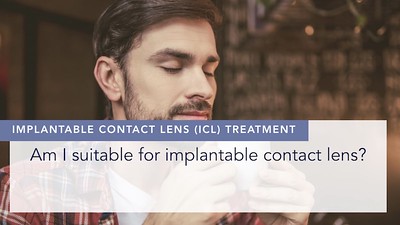Interview transcription
We interviewed Alex Shortt to find out what an implantable contact lens is and whether it is visible in the eye.
Interviewer: What does an ICL actually look like? How does it appear in the eye?
Alex Shortt: It’s funny you should mention that because what I’ve got here is a model. This is a magnified zoomed up model of an implantable contact lens. It’s made of an extremely soft polymer plastic but it’s a very sophisticated material. It’s a mixture of the protein collagen, which all our bodies are made up of and biomedical plastic. This is important because the body does not recognise this as a plastic lens implant but as biological tissue. Therefore it’s unheard of to get a reaction or any problems that are related to implants in the eye.
The other huge benefit of these implants is that they are so soft and so flexible that they can be placed in the eye through an incision that is only 2.4 millimetres in diameter. I mean, that’s absolutely tiny. They are so soft that they fold up, go in through the incision and expand in the eye where they are gently placed into position behind the iris. So they sit over the pupil but behind the coloured part of the eye, and they actually sit on the surface of the natural lens of the eye.
Interviewer: So can anyone see that you have an implantable contact lens?
Alex Shortt: Absolutely not. The lens actually sits behind your iris, which is the coloured part. They’re completely transparent and there’s no glint or reflex off it. So it’s impossible to see unless you know what you’re looking for. Even ophthalmologists sometimes struggle to identify where the lens implant starts and where the natural lens starts. The two just look like one structure. It’s incredible technology.
Interviewer: The first thing that pops into my mind is somebody who might have an implantable contact lens on top of their natural lens. Does that in any way interfere with any future cataract surgery procedures or anything along the lines?
Alex Shortt: A great thing about these ICL lens implants is that they are so easy to remove. They are so flexible that again via a 2.4-millimetre tiny incision, they can simply be removed. It’s a completely reversible procedure.
If you’d like to know more about vision corrective surgery, book a free initial screening today and I will personally answer your questions. Alternatively, take our free suitability quiz to find out which treatment you are suitable for.

About the author
Mr Alex J. Shortt | Consultant Ophthalmic Surgeon
MB BCh MSc PhD FRCOphth PGDipCatRef
I’m Alex Shortt, a highly trained academic researcher and Consultant Ophthalmic Surgeon based in London’s famous Harley Street medical district. I trained and worked as a consultant for 14 years at London’s Moorfields Eye Hospital. I specialise in advanced technologies for correcting vision, including cataract surgery, implantable contact lenses and laser vision correction.






